Mushrooms
Media

Species Types
Scientific Name
Desarmillaria caespitosa (formerly Armillaria tabescens)
Description
The ringless honey mushroom is honey-colored, with a dry, scaly cap, and lacks a ring on the stalk. It grows in clusters at the bases of trees or stumps, especially of oaks, and over buried wood.
Media

Species Types
Scientific Name
Coprinellus micaceus (formerly Coprinus micaceus)
Description
The mica cap has a bell-shaped, tawny brown, radially lined cap and inky gills. It grows in clusters around stumps or on wood debris.
Media
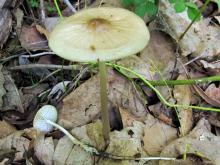
Species Types
Scientific Name
Xerula furfuracea (Collybia radicata var. furfuracea)
Description
The rooted collybia has a moist, wrinkled, grayish brown flat cap and a long, slender stalk that continues underground. It grows singly or scattered on and around deciduous trees and stumps.
Media

Species Types
Scientific Name
Pleurotus ostreatus and P. pulmonarius
Description
Oyster mushrooms are choice edibles with broad, fleshy, whitish, grayish, or tan caps and a stubby, off-center stalk. They grow clustered on stumps, logs, and trunks.
Media
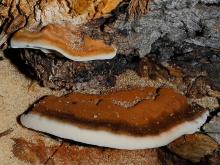
Species Types
Scientific Name
Ischnoderma resinosum
Description
The resinous polypore is a large, thick, velvety, brownish bracket fungus with a thick margin and whitish pores. It grows on logs and stumps of deciduous trees.
Media

Species Types
Scientific Name
Ganoderma sessile (formerly G. lucidum)
Description
The ling chih is a hard, usually flat, zoned bracket fungus with a reddish brown, shiny top. It grows at the base of living and dead deciduous trees, and also around stumps.
Media
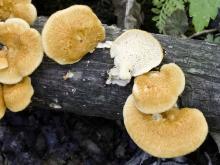
Species Types
Scientific Name
Polyporus alveolaris (formerly Favolus alveolaris)
Description
This polypore is an orange to tan, fan-shaped bracket that is scaly on top; the underside has rows of white, six-sided, radially arranged pores. It grows singly or in groups on dead branches of deciduous trees.
Media
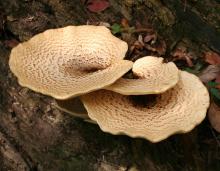
Species Types
Scientific Name
Polyporus squamosus
Description
The dryad's saddle is a large, fleshy, scaly, yellowish tan bracket fungus with large, yellowish white pores and a short stalk; it smells like watermelon rind. It grows singly or in layers, on living or dead deciduous wood.
Media
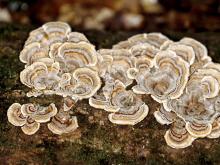
Species Types
Scientific Name
Trametes versicolor
Description
Turkey tail grows in clusters of leathery, thin brackets with multicolored zones above and whitish yellow pores below. Look for it on stumps and logs of deciduous trees.
Media

Species Types
Scientific Name
Grifola frondosa
Description
Looking like a ruffled chicken, the edible hen of the woods mushroom grows like large circular bouquet of spoon-shaped caps, each grayish brown on top and white beneath, emerging from a branching, whitish base. It grows on the ground at the base of oak trees.
See Also



Media

Species Types
Scientific Name
Monotropa hypopitys
Description
Pinesap is a plant that puts the "wild" in wildflower! It lacks chlorophyll, so its roots connect to fungi underground and absorb nutrients from the fungi.
Media

Species Types
Scientific Name
Cladophora, Pithophora, and Spirogyra spp., and others
Description
Filamentous green algae forms green, cottony masses that are free-floating or attached to rocks, debris, or other plants.
Media

Species Types
Scientific Name
Monotropa uniflora
Description
Indian pipe lacks chlorophyll, so it is white, not green. Below ground, its roots join with fungi that connect to tree roots. This plant, then, takes nourishment indirectly from the trees.
About Mushrooms in Missouri
Mushrooms are a lot like plants, but they lack chlorophyll and have to take nutrients from other materials. Mushrooms are neither plants nor animals. They are in a different kingdom — the fungi. Fungi include the familiar mushroom-forming species, plus the yeasts, molds, smuts, and rusts.
Always be cautious when eating edible mushrooms. Be absolutely sure of the ID, and only eat a small amount the first time you try it to avoid a reaction..





















